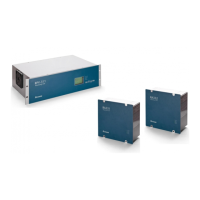3.3.1 DESCRIPTION
After the fault location calculations are performed, the distance to fault is displayed on the software interface
and it is made available via MODBUS communication according to the MODBUS IDs configured on the
Transmission Line configuration menu and the IP address configured in the windows Ethernet properties of
the RPV Manager computer.
Whenever a TW fault location is performed the RPV Manager will provide three separate 16-bit MODBUS
registers. The registers are described below:
MODBUS identifier configured on the
Transmission Line menu used to identify which
transmission line the current fault location refers
to.
As the fault location is split into 2x16-bit register.
This register carries the LSBs (least significant bits)
of the 32-bit register.
Second part of the fault location. This register
carries the MSBs (most significant bits) of the 32-
bit register.
In order to achieve the actual fault location it is necessary to combine the 2 fault location registers (30002
and 30003) into a single 32-bit value. The register 30003 is a decimal representation of the 16 most
significant bits of the complete 32-bit register which contains the fault location and the register 30002 is a
decimal representation of the 16 least significant bits of the 32-bit register. The combination of them will
result in the actual fault location in meters.
Below is the necessary operation to combine both fault location registers:
Actual fault location in meters = ((Register_2 & 0XFFFF) | (Register_3 << 16))
3.3.2 TW FAULT LOCATION METHODS
The RPV Manager uses two calculation methods for TW fault location. They are called “Basic” and
“Advanced”. The method used for each calculation is identified on the RPV Manager interface, as shown in
Figure 95. The two methods are described below:
Basic Method
Uses a threshold configured on the Transmission Line menu, which is a percentage value of the full scale of
the register, to identify the beginning of the traveling wave created by the fault and, consequently, to find its
timestamp in order to use in TWFL calculations. This method uses only the high frequency COMTRADE files
acquired by the RA333 units locate the fault.
Advanced Method
This method uses both the fault register (waveform at 50/60Hz) and the TW register (high frequency register)
to identify the fault location. The fault register is analyzed using a high-pass filter filter in order to find the time
window that contains the fault begging, then that time window is used in the TW register to enhance the

